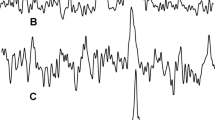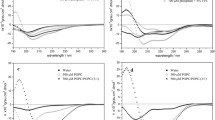Abstract
Brevinin-1BYa is a 24-amino acid residue host-defense peptide, first isolated from skin secretions of the foothill yellow-legged frog Rana boylii. The peptide is of interest, as it shows broad-spectrum antimicrobial activity, and is particularly effective against opportunistic yeast pathogens. Its potential for clinical use, however, is hindered by its latent haemolytic activity. The structures of two analogues, the less haemolytic [C18S,C24S]brevinin-1BYa and the more potent cis-dicarba-brevinin-1BYa, were investigated in various solution and membrane-mimicking environments by \({}^{1}\hbox {H-NMR}\) spectroscopy and molecular modelling techniques. Neither peptide possesses a secondary structure in aqueous solution. In both the membrane-mimicking sodium dodecyl sulphate micelles and 33% 2,2,2-trifluoroethanol (\(\hbox {TFE-d}_{3})\hbox {-H}_{2}\hbox {O}\) solvent mixture, the peptides’ structures are characterised by two \(\upalpha\)-helices connected by a flexible hinge located at the \(\hbox {Gly}^{13}/\hbox {Pro}^{14}\) residues. With the aid of molecular dynamics simulations and paramagnetic probes, it was determined that the peptides’ helical segments lie parallel to the micellar surface, with their hydrophobic residues facing towards the micelle core and the hydrophilic residues pointing outwards, suggesting that both peptides exert their biological activity by a non-pore-forming mechanism. Unlike that of the dicarba analogue, the C-terminus of the acyclic peptide is only weakly associated with the micellar surface and is in direct contact with the surrounding aqueous solvent.








Similar content being viewed by others
References
Bax A, Davis DG (1969) MLEV-17-based two-dimensional homonuclear magnetization transfer spectroscopy. J Magn Reson (1985) 65:355–360. https://doi.org/10.1016/0022-2364(85)90018-6
Benetti S, Timmons PB, Hewage CM (2019) NMR model structure of the antimicrobial peptide maximin 3. Eur Biophys J 48:203–212. https://doi.org/10.1007/s00249-019-01346-7
Beyaz A, Oh WS, Reddy V (2004) Ionic liquids as modulators of the critical micelle concentration of sodium dodecyl sulfate. Colloids Surf B Biointerfaces 35:119–124. https://doi.org/10.1016/J.COLSURFB.2004.02.014
Biller JR, Elajaili H, Meyer V, Rosen GM, Eaton SS, Eaton GR (2005) Scalable molecular dynamics with NAMD. J Comput Chem 26:1781–1802. https://doi.org/10.1016/j.jmr.2013.08.006
Chen Y, Guarnieri MT, Vasil AI, Vasil ML, Mant CT, Hodges RS (2007) Role of peptide hydrophobicity in the mechanism of action of alpha-helical antimicrobial peptides. Antimicrob Agents Chemother 51:1398–406. https://doi.org/10.1128/AAC.00925-06
Conlon JM, Kolodziejek J, Nowotny N (2004) Antimicrobial peptides from ranid frogs: taxonomic and phylogenetic markers and a potential source of new therapeutic agents. Biochimica et Biophysica Acta Proteins Proteom 1696:1–14. https://doi.org/10.1016/j.bbapap.2003.09.004
Conlon JM, Sonnevend A, Patel M, Davidson C, Nielsen PF, Pál T, Rollins-Smith LA (2003) Isolation of peptides of the brevinin-1 family with potent candidacidal activity from the skin secretions of the frog Rana boylii. J Pept Res 62:207–13
Darden T, York D, Pedersen L (1993) Particle mesh Ewald: An N.log(N) method for Ewald sums in large systems. J Chem Phys 98:10089–10092. https://doi.org/10.1063/1.464397
Feller SE, Zhang Y, Pastor RW, Brooks BR (1995) Constant pressure molecular dynamics simulation: the Langevin piston method. J Chem Phys 103:4613–4621. https://doi.org/10.1063/1.470648
Guilhelmelli F, Vilela N, Albuquerque P, Derengowski LdS, Silva-Pereira I, Kyaw CM (2013) Antibiotic development challenges: the various mechanisms of action of antimicrobial peptides and of bacterial resistance. Front Microbiol 4:353. https://doi.org/10.3389/fmicb.2013.00353
Güntert P, Braun W, Wüthrich K (1991) Efficient computation of three-dimensional protein structures in solution from nuclear magnetic resonance data using the program DIANA and the supporting programs CALIBA, HABAS and GLOMSA. J Mol Biol 217:517–530. https://doi.org/10.1016/0022-2836(91)90754-T
Güntert P, Mumenthaler C, Wüthrich K (1997) Torsion angle dynamics for NMR structure calculation with the new program Dyana. J Mol Biol 273:283–298. https://doi.org/10.1006/JMBI.1997.1284
Hossain MA, Guilhaudis L, Sonnevend A, Attoub S, van Lierop BJ, Robinson AJ, Wade JD, Conlon JM (2011) Synthesis, conformational analysis and biological properties of a dicarba derivative of the antimicrobial peptide, brevinin-1BYa. Eur Biophys J 40:555–564. https://doi.org/10.1007/s00249-011-0679-2
Hultmark D (2003) Drosophila immunity: paths and patterns. Current Opin Immunol 15:12–19. https://doi.org/10.1016/S0952-7915(02)00005-5
Humphrey W, Dalke A, Schulten K (1996) VMD: visual molecular dynamics. J Mol Gr 14:33–38. https://doi.org/10.1016/0263-7855(96)00018-5
Jakobtorweihen S, Ingram T, Smirnova I (2013) Combination of COSMOmic and molecular dynamics simulations for the calculation of membrane-water partition coefficients. J Comput Chem 34:1332–1340. https://doi.org/10.1002/jcc.23262
Jorgensen WL, Chandrasekhar J, Madura JD, Impey RW, Klein ML (1983) Comparison of simple potential functions for simulating liquid water. J Chem Phys 79:926–935. https://doi.org/10.1063/1.445869
Kumar A, Ernst R, Wüthrich K (1980) A two-dimensional nuclear overhauser enhancement (2D NOE) experiment for the elucidation of complete proton–proton cross-relaxation networks in biological macromolecules. Biochem Biophys Res Commun 95:1–6. https://doi.org/10.1016/0006-291X(80)90695-6
Kwon MY, Hong SY, Lee KH (1998) Structure-activity analysis of brevinin 1E amide, an antimicrobial peptide from Rana esculenta. Biochimica et Biophysica Acta (BBA) Protein Struct Mol Enzymol 1387:239–248. https://doi.org/10.1016/S0167-4838(98)00123-X
Lee W, Tonelli M, Markley JL (2015) NMRFAM-SPARKY: enhanced software for biomolecular NMR spectroscopy. Bioinformatics 31:1325–1327. https://doi.org/10.1093/bioinformatics/btu830
Lindberg M, Gräslund A (2001) The position of the cell penetrating peptide penetratin in SDS micelles determined by NMR. FEBS Lett 497:39–44. https://doi.org/10.1016/S0014-5793(01)02433-4
MacKerell AD, Bashford D, Bellott M, Dunbrack RL, Evanseck JD, Field MJ, Fischer S, Gao J, Guo H, Ha S, Joseph-McCarthy D, Kuchnir L, Kuczera K, Lau FTK, Mattos C, Michnick S, Ngo T, Nguyen DT, Prodhom B, Reiher WE, Roux B, Schlenkrich M, Smith JC, Stote R, Straub J, Watanabe M, Wiórkiewicz-Kuczera J, Yin D, Karplus M (1998) All-atom empirical potential for molecular modeling and dynamics studies of proteins. J Phys Chem B 102:3586–3616. https://doi.org/10.1021/jp973084f
MacKerell AD, Feig M, Brooks CL (2004) Extending the treatment of backbone energetics in protein force fields: limitations of gas-phase quantum mechanics in reproducing protein conformational distributions in molecular dynamics simulation. J Comput Chem 25:1400–1415. https://doi.org/10.1002/jcc.20065
MacRaild CA, Illesinghe J, Van Lierop BJ, Townsend AL, Chebib M, Livett BG, Robinson AJ, Norton RS (2009) Structure and activity of (2,8)-dicarba-(3,12)-cystino \(\alpha\)-ImI, an a-conotoxin containing a nonreducible cystine analogue. J Med Chem 52:755–762. https://doi.org/10.1021/jm8011504
Martyna GJ, Tobias DJ, Klein ML (1994) Constant pressure molecular dynamics algorithms. J Chem Phys 101:4177–4189. https://doi.org/10.1063/1.467468
Mechkarska M, Ojo OO, Meetani MA, Coquet L, Jouenne T, Abdel-Wahab YH, Flatt PR, King JD, Conlon JM (2011) Peptidomic analysis of skin secretions from the bullfrog Lithobates catesbeianus (Ranidae) identifies multiple peptides with potent insulin-releasing activity. Peptides 32:203–208. https://doi.org/10.1016/J.PEPTIDES.2010.11.002
Pál T, Abraham B, Sonnevend A, Jumaa P, Conlon JM (2006) Brevinin-1BYa: a naturally occurring peptide from frog skin with broad-spectrum antibacterial and antifungal properties. Int J Antimicrob Agents 27:525–9. https://doi.org/10.1016/j.ijantimicag.2006.01.010
Park SH, Kim HE, Kim CM, Yun HJ, Choi EC, Lee BJ (2002) Role of proline, cysteine and a disulphide bridge in the structure and activity of the anti-microbial peptide gaegurin 5. Biochem J 368:171–82. https://doi.org/10.1042/BJ20020385
Park SH, Kim YK, Park JW, Lee B, Lee BJ (2000) Solution structure of the antimicrobial peptide gaegurin 4 by H and 15N nuclear magnetic resonance spectroscopy. Eur J Biochem 267:2695–2704
Ryckaert JP, Ciccotti G, Berendsen HJC (1977) Numerical integration of the Cartesian equations of motion of a system with constraints: molecular dynamics of n-alkanes. J Comput Phys 23:321–341
Sani MA, Separovic F (2016) How membrane-active peptides get into lipid membranes. Acc Chem Res 49:1130–1138. https://doi.org/10.1021/acs.accounts.6b00074
Sani MA, Whitwell TC, Gehman JD, Robins-Browne RM, Pantarat N, Attard TJ, Reynolds EC, O’Brien-Simpson NM, Separovic F (2013) Maculatin 1.1 disrupts Staphylococcus aureus lipid membranes via a pore mechanism. Antimicrob Agents Chemother 57:3593–600. https://doi.org/10.1128/AAC.00195-13
Subasinghage AP, O’Flynn D, Conlon JM, Hewage CM (2011) Conformational and membrane interaction studies of the antimicrobial peptide alyteserin-1c and its analogue [E4K]alyteserin-1c. Biochimica et Biophysica Acta (BBA) Biomemb 1808:1975–1984. https://doi.org/10.1016/j.bbamem.2011.04.012
Suh JY, Lee KH, Chi SW, Hong SY, Choi BW, Moon HM, Choi BS (1996) Unusually stable helical kink in the antimicrobial peptide—a derivative of gaegurin. FEBS Lett 392:309–312. https://doi.org/10.1016/0014-5793(96)00840-X
Timmons PB, O’Flynn D, Conlon JM, Hewage CM (2019) Structural and positional studies of the antimicrobial peptide brevinin-1BYa in membrane-mimetic environments. J Pept Sci. https://doi.org/10.1002/psc.3208 (in press)
Wüthrich K (1986) NMR of proteins and nucleic acids. Wiley Interscience. https://www.wiley.com/en-ie/NMR+of+Proteins+and+Nucleic+Acids-p-9780471828938
Yeaman MR, Yount NY (2003) Mechanisms of antimicrobial peptide action and resistance. Pharmacol Rev 55:27–55. https://doi.org/10.1124/pr.55.1.2
Zhang S, Hughes RA, Bathgate RA, Shabanpoor F, Hossain MA, Lin F, Van Lierop B, Robinson AJ, Wade JD (2010) Role of the intra-A-chain disulfide bond of insulin-like peptide 3 in binding and activation of its receptor, RXFP2. Peptides 31:1730–1736. https://doi.org/10.1016/j.peptides.2010.05.021
Acknowledgements
We are grateful to University College Dublin for Research Scholarship to PBT and DOF. Authors would like to acknowledge the funding from Science Foundation Ireland for the NMR spectrometer upgrade. The authors also wish to acknowledge the DJEI/DES/SFI/HEA Irish Centre for High-End Computing (ICHEC) for the provision of computational facilities and support. Structural coordinates and chemical shifts were deposited in the PDB at RCSB (codes in Table 1).
Author information
Authors and Affiliations
Corresponding author
Additional information
Publisher's Note
Springer Nature remains neutral with regard to jurisdictional claims in published maps and institutional affiliations.
Electronic supplementary material
Below is the link to the electronic supplementary material.
Rights and permissions
About this article
Cite this article
Timmons, P.B., O’Flynn, D., Conlon, J.M. et al. Insights into conformation and membrane interactions of the acyclic and dicarba-bridged brevinin-1BYa antimicrobial peptides. Eur Biophys J 48, 701–710 (2019). https://doi.org/10.1007/s00249-019-01395-y
Received:
Revised:
Accepted:
Published:
Issue Date:
DOI: https://doi.org/10.1007/s00249-019-01395-y




